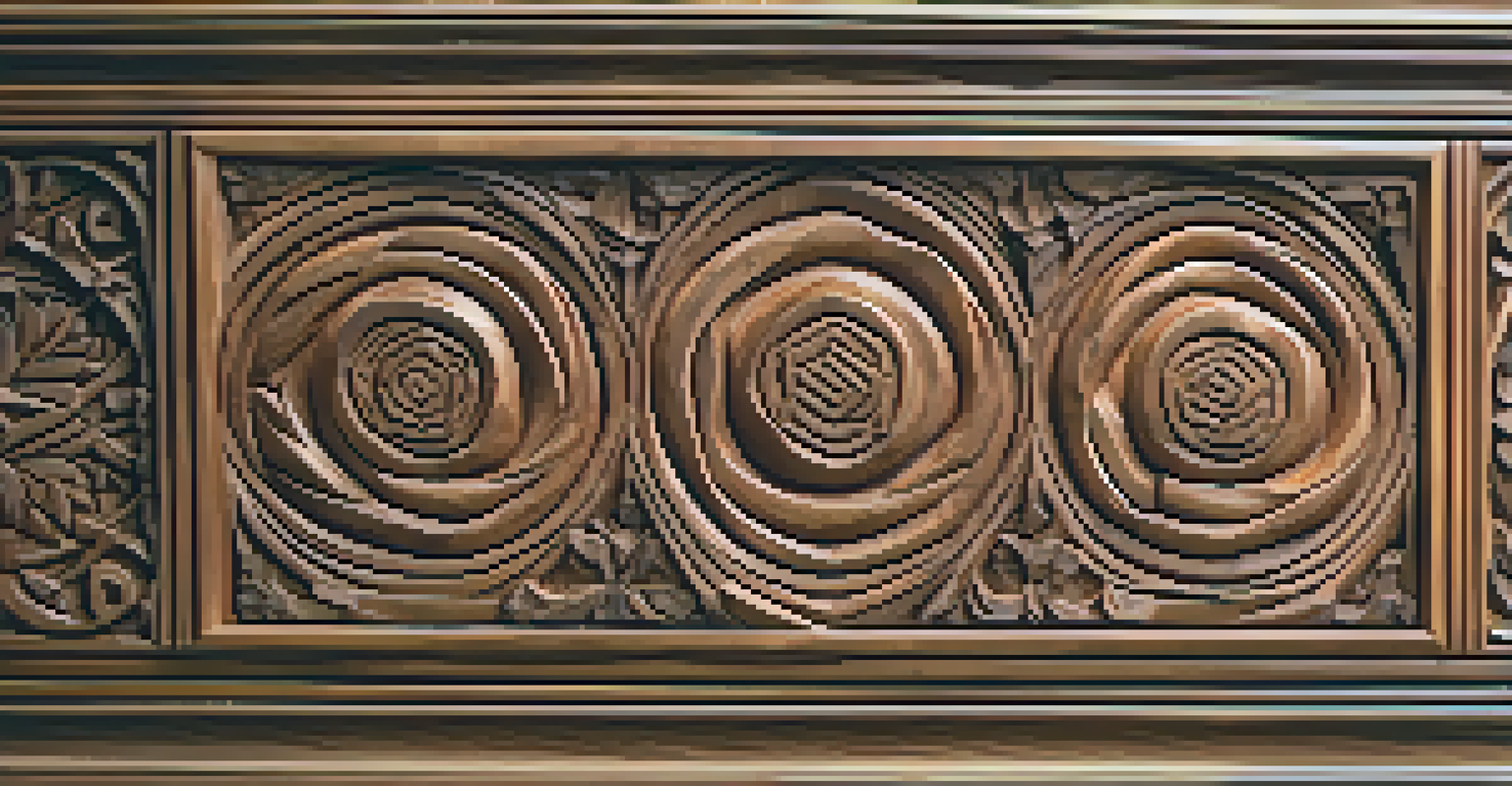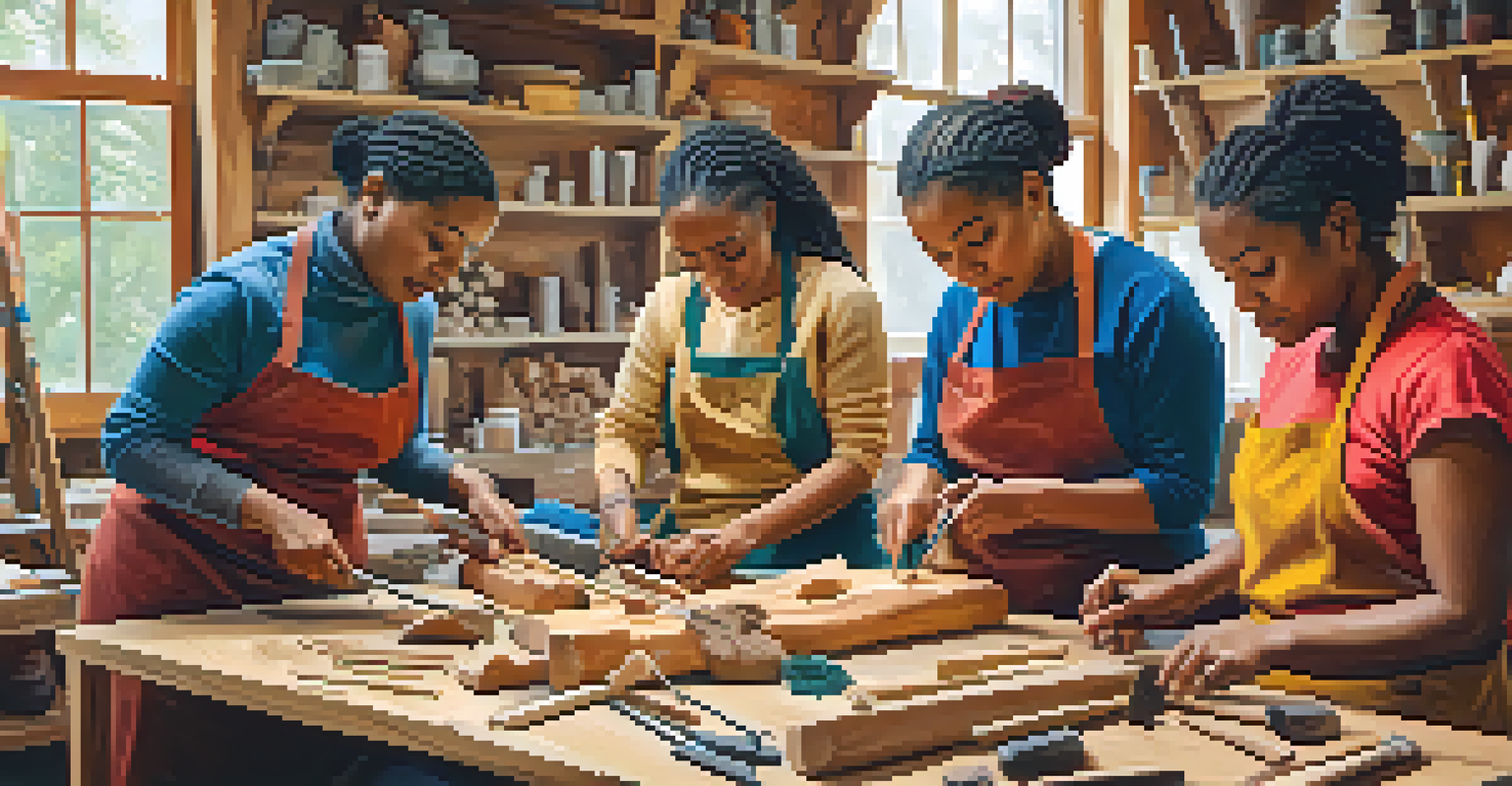Gender Representation in Traditional Carving Practices Today

Understanding Traditional Carving Practices
Traditional carving is an ancient craft that holds cultural significance across many societies. It often involves intricate techniques passed down through generations, reflecting not only artistry but also the values and narratives of a community. The materials, styles, and themes used in carving can vary widely, showcasing the uniqueness of different regions. However, the question of who engages in these practices often reveals underlying gender dynamics.
Art is a reflection of society, and by understanding the roles of gender in traditional crafts, we can better appreciate the stories they tell.
In many cultures, carving has historically been a male-dominated field. This can be traced back to societal norms and expectations that have shaped the roles individuals play in artistic communities. Men are often seen as the primary artisans, while women's contributions, if acknowledged at all, tend to be marginalized. Understanding this context is crucial when examining contemporary practices in carving.
As we delve deeper into these traditions, it becomes clear that gender representation in carving is not just about numbers. It's about the narratives woven into the art itself and the visibility of different voices within the craft. By recognizing the contributions of all genders, we can appreciate the richness of traditional carving practices more fully.
Historical Gender Roles in Carving
Historically, gender roles in many societies have dictated who gets to engage in certain crafts, including carving. In numerous cultures, men often took on the role of the primary carver, seen as the breadwinners and protectors of their families. Conversely, women were frequently relegated to supporting roles, such as gathering materials or preparing tools, which, while essential, did not receive the same recognition. This division has long-lasting effects on how we perceive gender within the craft.

For instance, in some Indigenous communities, traditional carving was seen as a rite of passage for males, while women were encouraged to focus on domestic arts. This created a legacy where the artistry of women was undervalued. Over time, these historical dynamics have contributed to the ongoing challenges women face in being acknowledged as skilled artisans in their own right.
Gender Dynamics in Carving Practices
Traditional carving has historically been male-dominated, with women's contributions often overlooked or marginalized.
Recognizing this historical context is vital for understanding current gender representation. It allows us to see how past injustices can influence present-day practices and perceptions, highlighting the importance of making space for all voices in the craft of carving.
Contemporary Shifts in Gender Dynamics
Today, we are witnessing a positive shift in the dynamics of gender representation within traditional carving practices. More women are stepping into roles traditionally held by men, challenging age-old stereotypes and redefining what it means to be a carver. This change is often fueled by a growing awareness of gender equality and the importance of inclusivity in the arts. As these shifts occur, we begin to see a richer tapestry of storytelling through carving.
Diversity in art is not just about inclusion; it’s about the richness of perspectives that shape our understanding of culture.
Many contemporary female carvers are not only creating stunning works of art but are also reclaiming their narratives and cultural heritage. They’re utilizing carving as a medium to express their identities and share stories that might have otherwise gone unheard. This resurgence of female voices in carving is a powerful testament to the ongoing evolution of gender roles in traditional crafts.
Moreover, these changes are inspiring younger generations to explore carving as a viable artistic pathway, regardless of gender. Workshops, mentorship programs, and community initiatives are fostering an environment where everyone feels empowered to participate in this ancient art form.
Celebrating Female Carvers and Their Contributions
Celebrating the achievements of female carvers is essential in recognizing their contributions to the craft. Many women have developed unique styles and techniques that not only reflect their personal experiences but also challenge traditional narratives. By highlighting these artists, we can inspire others to appreciate the diversity within carving practices and understand the richness that different perspectives bring to the craft.
These female artisans often draw inspiration from their cultural backgrounds, creating pieces that resonate with their communities and beyond. For instance, some may incorporate symbols and motifs that represent women's roles in their societies, weaving narratives into their work that speak to broader themes of empowerment and resilience. This connection between artistry and storytelling enhances the significance of their creations.
Emerging Female Voices in Carving
Contemporary female carvers are reclaiming their narratives, challenging stereotypes, and fostering inclusivity in the craft.
Exhibitions showcasing the work of female carvers also play a crucial role in elevating their visibility. By providing platforms for these artists to share their work, we not only celebrate their talents but also foster a deeper understanding of the importance of gender representation in traditional crafts.
Challenges Faced by Women in Traditional Carving
Despite the progress made, women in traditional carving still face numerous challenges. Access to resources, training, and recognition can be limited, creating barriers for those aspiring to pursue carving as a profession. Additionally, societal attitudes can sometimes perpetuate the belief that carving is primarily a male activity, discouraging women from fully engaging in the craft.
Another significant challenge is the need for work-life balance, especially for women who may also juggle family responsibilities. This can lead to a lack of time and energy to dedicate to carving, further complicating their participation in the craft. Addressing these barriers is essential for ensuring that women can thrive in the field of traditional carving.
Support networks and community initiatives are crucial in overcoming these challenges. By fostering environments where women can connect, share experiences, and access resources, we can contribute to a more equitable landscape in traditional carving practices.
The Role of Education in Carving Practices
Education plays a pivotal role in shaping the future of traditional carving practices, especially regarding gender representation. By incorporating inclusive curricula that highlight the contributions of both male and female carvers, educational institutions can foster a more balanced perspective on the craft. Workshops, classes, and mentorship programs focused on inclusivity can encourage participation from all genders.
Furthermore, educational initiatives that spotlight female carvers can inspire young girls to explore their creative potential in carving. When students see successful women in traditional crafts, it can break down barriers and encourage them to pursue their passions unapologetically. This ripple effect can lead to a more diverse and vibrant carving community.
Education's Role in Inclusivity
Inclusive education and mentorship programs are essential for encouraging participation from all genders in traditional carving.
By actively promoting education and inclusivity, we can cultivate a generation of carvers who appreciate the importance of gender representation in their craft. This foundational change can lead to a more equitable future, where talent and creativity are celebrated regardless of gender.
Looking Ahead: A More Inclusive Future for Carving
As we look to the future, it’s clear that fostering inclusivity in traditional carving practices must remain a priority. This involves not only recognizing the contributions of women but also actively creating spaces where all voices can be heard. Encouraging collaboration between male and female carvers can lead to innovative approaches and a richer exchange of ideas within the craft.
Moreover, promoting awareness about the history of gender representation in carving can help dismantle stereotypes and foster understanding. By sharing stories of pioneering female carvers and their journeys, we can inspire others to challenge norms and pursue their artistic passions. This awareness can also encourage communities to support and uplift all artisans, regardless of gender.

Ultimately, a more inclusive future for traditional carving practices will enrich the art form itself. As diverse perspectives and experiences continue to shape the craft, we can expect to see an evolution that honors tradition while embracing modernity, leading to a vibrant tapestry of creativity that reflects the richness of our shared human experience.